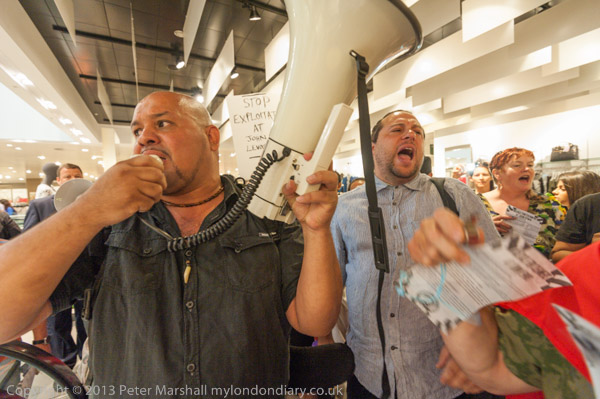
On the John Lewis web site it proudly states: ” Our founder’s vision of a successful business powered by its people and its principles defines our unique company today. The profits and benefits created by our success are shared by all our Partners.” What it fails to say is that they are not shared by all who work in their stores and pay a vital role in the running of the organisation. The cleaners are not partners, not employed by John Lewis. They get poverty wages – £6.72 per hour, over 20% less than the London Living Wage determined each year by the Greater London Authority and promoted by London Mayor Boris Johnson, backed by David Cameron. They also have much poorer working conditions, and don’t get the pension, holiday and sick pay provisions enjoyed by other workers (“partners”) in John Lewis, as well of course at missing out on the large bonuses enjoyed by the partners from the group’s profits.
John Lewis is a good place to work, unless you are a cleaner. For cleaners in John Lewis Westfield it is the same as working for other greedy employers – they are overworked, underpaid, have unsocial hours, lousy and often unsafe work environment, with management that often treats them “like the dirt they clean” while making fat profits from the contractors. They are not employed by John Lewis but by ICM, part of the Compass Group, who recently announced pre-tax profits for the year of £575 million.
The cleaners’ union IWGB has been calling for a living wage for cleaners and in particular for all who work in John Lewis to be considered as partners in its success for some time, with a series of high-profile protests at its Oxford St store last summer. Their campaign has attracted some support from those they work with in the stores, and last year one of the partners in the store overlooking the Olympic site in Stratford’s huge Westfield shopping centre gave an interview to The Guardian expressing his support. Various interviews and disciplinary procedures later and he was out of a job (an appeal against the decision is pending.)
The cleaners decided to take their protest to Westfield both as it is one of John Lewis’s highest profile stores, but also as a gesture of solidarity towards the sacked partner who came with them and spoke briefly during the protest. I received an invitation to attend and report on the event though I had no detailed information on the protest, which was unannounced, in advance, just a time and place to meet. When I got there on time there was no sign of the others, but I made a phone call to check and was assured it was going ahead, and a few minutes later people started to gather.
We’d met a short distance from Westfield, which, like other large shopping centres, is a private estate with its own security team and one that does not encourage photography. If I walked though its fairly crowded streets openly taking pictures I would expect to be quickly spotted on the many CCTV cameras, accosted and asked to stop and probably escorted out of the area – as I know has happened to some photographers. So while we walked through to John Lewis at the far end of the mall I was being very discrete in taking pictures of a group who were also trying to be unobtrusive! Unsurprisingly the pictures weren’t much.
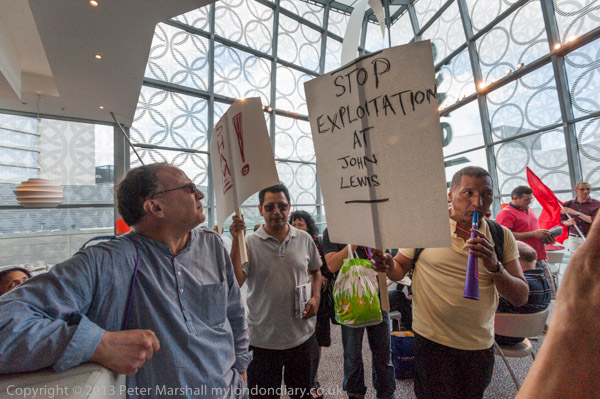
Bright windows, dim interior – but Lightroom came to my rescue
Inside John Lewis we kept a low profile as the group – I think by this time around 40 people – made its way to the eating area on the top floor where they sat at tables and brought out their placards, union flags, banners, plastic horns, whistles and megaphones from their bags and got ready to make their surprise protest. I could start photographing more openly, but the light was very difficult, bright near the large windows, but very dim in areas away from them, and the contrast too high to handle.
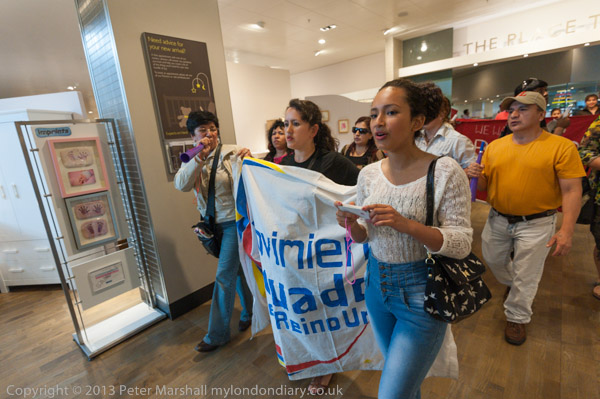
Once the protesters marched out into the brightly lit store area and began their noisy protest things became much easier. I didn’t need to be discreet, and the light levels made work easier. I needed a reasonably fast shutter speed because there was a lot of movement, and at ISO3200 was able to work at around 1/125 or 1/200th with the 16-35mm f4 lens at around f5.6. At 16mm there was enough depth of field.
The protesters made a short protest on each of three levels of the store. The staff and customers generally just stood and watched (a few of both applauded) and some of the managers told them to leave, but I saw little real argument and the whole atmosphere was really rather civilised – as you might expect from John Lewis. There was absolutely no interference with me taking pictures inside the store, no request made to me to stop, though I did as much as possible keep close to the protesters.
As often with artificial lighting, colour temperature was a problem. Working with raw images, I generally let Nikon’s auto white balance have its way and then correct in Lightroom. Using the eye dropper on a presumed neutral area is usually a good start point, though it isn’t always easy to find a true neutral. Assuming that you can, the result isn’t quite what I want, as it looks too cold. Interior lighting generally looks right a little warmer than neutral, almost whatever it was actually like, and flesh tones in particular can look almost ghoulish without a little warmth.
Much artificial lighting also departs rather from a smoothly continuous spectrum which can also cause problems. Back in the old, old days photographers had to juggle with colour correction filters when using transparency film, but fortunately we can do all that now in post production.
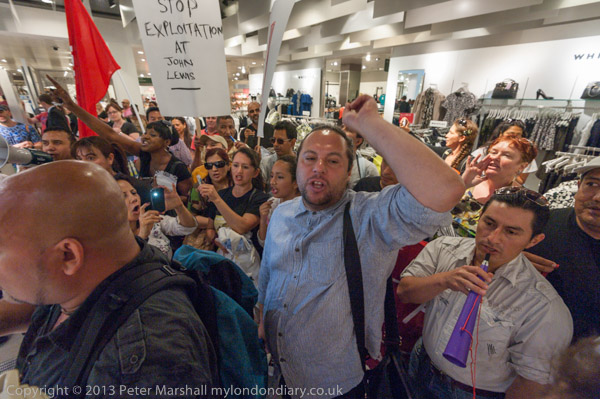
It’s a relatively simple job if you are shooting in a single area all lit by the exactly the same type of illumination – balance one image and synchronise the whole set. But inside John Lewis the protesters were moving around, on the shop floor, on the escalators and the balance changed, giving me a little more work. As you’ll see I haven’t always ended up with the same result on different images, even those taken in the same place.

Some of the images I put on the web are smaller versions of those that go into an agency within a few hours of taking the pictures, and they are certainly not perfect. So far I’ve refused to wire direct from location so I can correct and edit the images better because I want. For those stories which are covered by other photographers who get their images in hours before me this is obviously commercial suicide, but much of what I cover is unlikely to be picked up by the mass media, more likely to be used by magazines and books in months to come rather than on tomorrows front (or even inside) page. Coming back home to look at the images on a reasonably large (24″) high quality screen, I import the images into Lightroom (with renaming and a development preset) and then look briefly at every image, making an initial selection tagging the better images with 2 stars. I then go through the’ 2 star’ images, looking for the strongest images but also trying to select a set that tell the story – and I mark these with a colour tag. The hardest part can come next, when I look at just the colour tagged images, and often find there are simply too many. Deciding which to choose can be tough.
Once I’ve made that choice (or if there were fairly few to start with) I then go to Lightroom’s Develop module and quickly work its magic on them. Then its back to the Library module to add keywords and captions before uploading them with the story.
For the web pages – such as Cleaners in John Lewis Westfield, I go back to the ‘2 star’ images and try to eliminate near duplicates and any weaker images (which all get put down to 1 star), and then develop the those which were not developed earlier. Usually I can take a little more time over the corrections and the results are usually better, but often different.
It’s even possible in Lightroom to make some corrections for mixed lighting, using the Adjustment Brush to paint areas of the image to alter the colour temperature and tint. So much is possible now that you could well spend all your time working in Lightroom (or Photoshop) and never have time to take another picture!

There was a slightly longer protest close to the entrance on the ground floor, with several short speeches, before the protesters, having made their point, moved into the mall outside. It had seemed a long protest, but the EXIF data shows it to have been only 15 minutes.
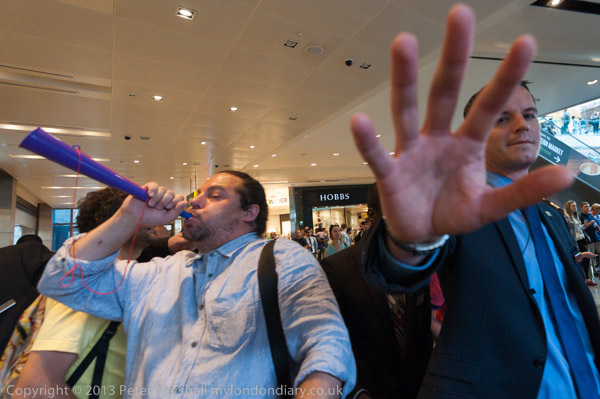
Waiting for them were the Westfield security manager and guards, who did try a little pushing people around, but were soon told to stop. One of them said to me “I think you’ve taken enough photographs” and held his had over my lens. I took a picture as I moved back and continued to photograph. After all, I hadn’t actually been told to stop, and it was purely my decision whether I had taken enough! The group was slowly and in its own time making its way out, stopping for a short protest outside another door of John Lewis, and then walking around the corner for some group photographs in front of one of the side windows of the store before dispersing after what felt like a very successful protest.
After it was all over we heard the siren as the police finally arrived. Sensibly they talked to both security and to the union’s general secretary and then stood back and did nothing. Protesters and security guards were by now chatting amicably – they too are low paid workers with often poor conditions. I walked away and through the large empty Stratford International station (at which no international trains stop) to the rather smaller DLR to start my journey home.
______________________________________________________
My London Diary : Buildings of London : River Lea/Lee Valley : London’s Industrial Heritage
All photographs on this and my other sites, unless otherwise stated are by Peter Marshall and are available for reproduction or can be bought as prints.
To order prints or reproduce images
________________________________________________________